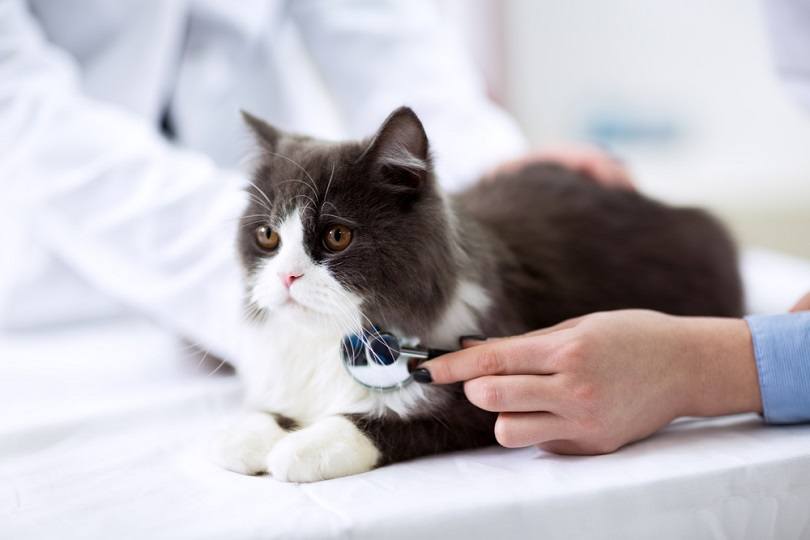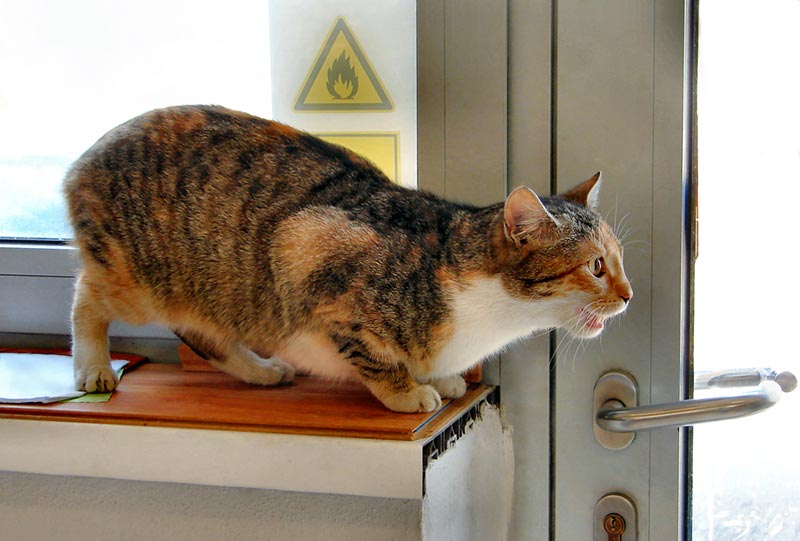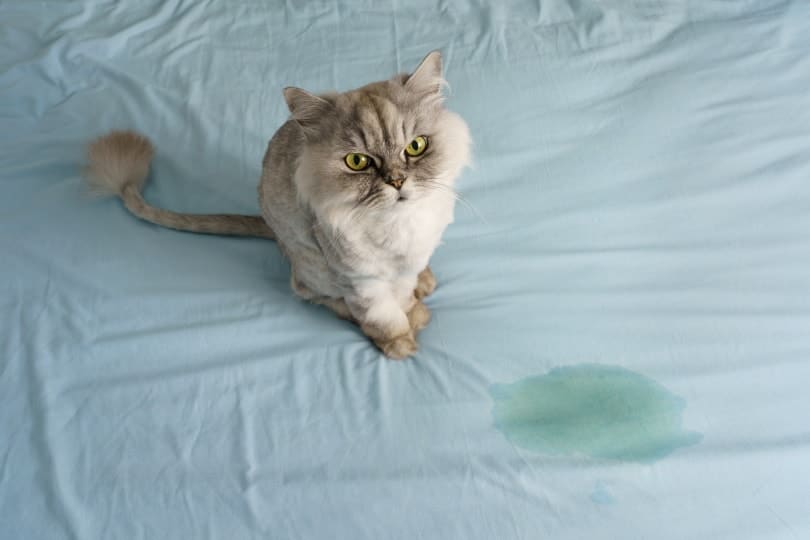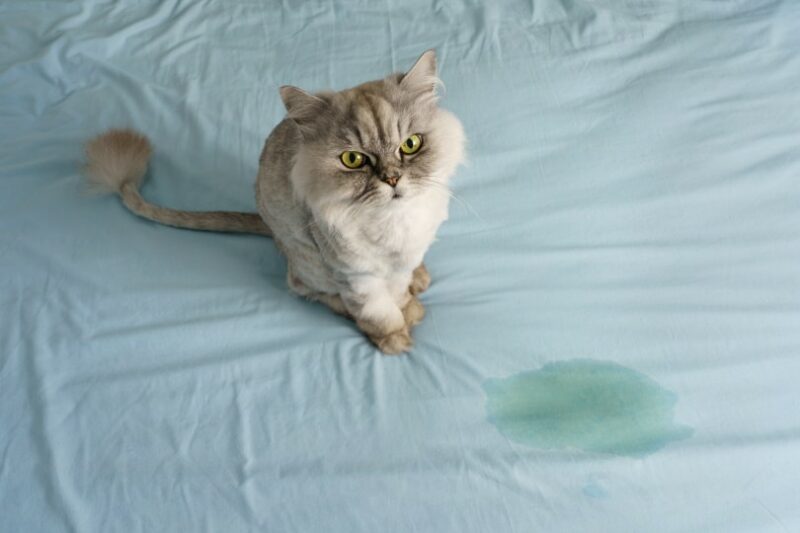Click to Skip Ahead
When you first realize that your cat has peed on your dog’s bed, your first thought may be anger, followed by confusion. Do they not like the dog? To make matters worse, cat urine is tough to remove. It will take several washes to eradicate the smelly cat urine. You may not even be able to get it all out.
You may consider punishing your cat or training them not to pee on your dog’s bed. However, that is unnecessary. As we’ll discuss, inappropriate peeing is often a sign of an underlying health condition, which will likely need to be treated by your vet.
Top 4 Reasons Why Your Cat May Pee on a Dog Bed
There are several reasons why your cat pees on your dog’s bed. Some are much more common than others. Many are easy to correct with a trip to your vet or some basic training. Others can indicate an underlying condition.
Either way, figuring out the why will often involve a lot of trial and error. If you take your cat to the vet, they may end up with a clean bill of health, for instance, which would rule out the chance of an underlying health condition causing the issue. It can be tough to determine the cause without using this method of elimination.
1. Medical Reasons
Several medical conditions can cause inappropriate marking from a cat. UTIs are the most common reason cats start suddenly peeing on things. It isn’t that they’re targeting the dog’s bed, but they can’t help it. The only way to treat this issue is to visit your vet.
It is essential to seek medical care since a UTI can get pretty serious. It can turn into a bladder or kidney infection, which can be deadly if it gets severe enough. If your cat usually doesn’t exhibit this behavior, it is likely a medical condition. You will need to take them to the vet for a complete exam, and they will likely need medication.

2. Territory Marking
Peeing in inappropriate places can also be a behavioral issue., which is more commonly seen in unneutered males, and in this context, it is a way of claiming a territory or object as their own.
If your dog is new (or your cat), it may be the reason for them peeing in the dog’s bed. Luckily, there are several methods to decrease and manage this behavior.
3. Heat Marking
Heat marking is different from average cat marking. This only occurs when an intact female is in heat. To attract a mate, they may begin peeing on objects and various surfaces. They’re spreading their scent to increase the odds of a male smelling it.
If your cat is female and has not been spayed yet, it is probably what is going on. The only way to fix it is to spay your cat or wait them out. The behavior will typically stop when they get out of heat. However, some females do it even when they are no longer in heat, and in that case, it could be territorial marking. These females need to be spayed to prevent this problem.

4. Cat Stress
Stress and anxiety can cause your cat to behave poorly, including peeing on your dog’s bed. Just like people tend to make bad decisions when stressed, your cat can make bad decisions as well. In these situations, the best way to stop the issue is to reduce the amount of stress your cat is experiencing.
How to Stop Cat From Peeing on Dog Bed
The way you make your pet stop peeing on the dog bed depends on why they are doing it. If a cat is sick, the only way to prevent them from peeing on the dog bed is to treat them. If the cat does it for behavioral reasons, then training might be in order.
Training
Sometimes, you may need to retrain your cat to use a litter box. This only works for cats that are peeing for behavioral reasons. Usually, this involves restricting the amount of space your cat has access to. You’ll need to enclose them in the area containing the litterbox to let them get more exposure to the box.
Add More Boxes
If you have multiple cats or a large home, you may need to use more than one litter box. If the box is on one side of the house and your cat happens to be on the other, they may decide that walking to it isn’t worth it.
Furthermore, some cats are sensitive when using the litter box after other cats. If you have multiple cats, you likely will need multiple litterboxes. Even if that doesn’t necessarily fix the underlying problem, it can be helpful in any case. It also prevents you from changing the litter in the boxes as often since two are available for your cat to use.
The first part of cat mess prevention is ensuring you are taking the time to properly clean any accidents - and that starts with investing in the right products! Of course, you'll want to opt for something safe first and foremost, to protect your feline's health, but secondly, you'll need a solution powerful enough to lift the toughest, stinkiest, most set-in stains. After careful consideration, we fell in love with one product and highly recommend it to all pet owners!
There are several reasons we can't get enough of the Hepper Advanced Bio-Enzyme Pet Stain & Odor Eliminator Spray. It permanently removes the very worst smells and stains, it can be used on a multitude of surfaces and its neutral scented, meaning no odor masking! It comes in a generous 32-oz bottle and comes with 100% satisfaction guarantee. Learn more about this holy grail of a cleaner here! At Catster, we’ve admired Hepper for many years, and decided to take a controlling ownership interest so that we could benefit from the outstanding products of this cool cat company!How to Effectively Clean Up Cat Messes, Odors & Stains
Our Favorite Enzyme Cleaner
Prevention is the Best Medicine
Typically, in this situation, prevention is the best medicine. Your cat’s health and the setup of your home will largely determine if your cat pees on the dog bed or not. Therefore, your best bet is to ensure that you have plenty of litterboxes spread throughout the house. Also, consider washing your dog’s bed more often and using a harsh smell-fighting liquid like vinegar.
If your cat shows signs of being sick, take them to the vet as soon as possible. The last thing you want is for a cat suffering from UTI to get worse, which can cause a whole host of issues on top of causing them to pee places they shouldn’t.
In the end, if you focus on providing the right environment for your cat and keeping them healthy, the odds of them peeing on something are low.
Next on your reading list:
- Cats Peeing in Sink or Bath Tub? 7 Ways to Stop it!
- 10 Best Cat Urine & Odor Removers (Enzyme Cleaners) – Reviews & Top Picks
Image Credit: Creative Cat Studio, Shuterstock
















